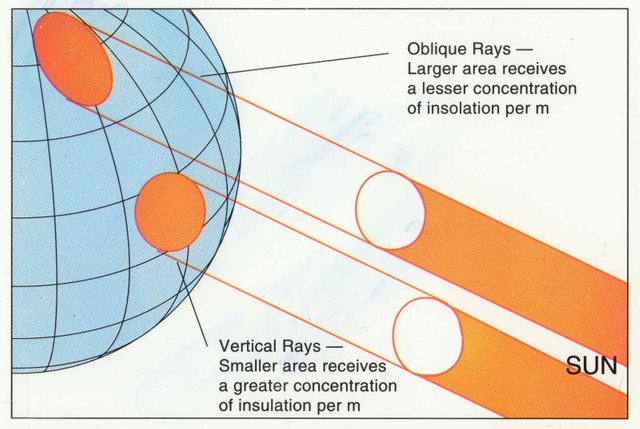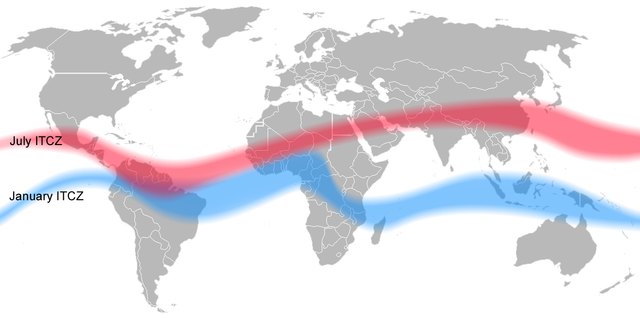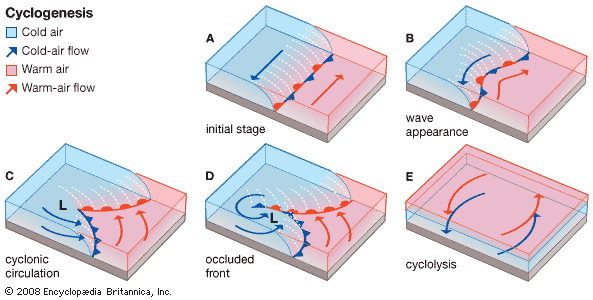Everyday Geography #5 Recognize your weather pattern
Global weather patterns vary strongly by geographical location. Some regions have a yearly wet and dry period while others have 4 well defined seasons or stay freezing cold all year. This differentiation in weather patterns can be easily explained using basic meteorological concepts. I will try to make it as simple as possible to keep this article short. If I really went into every detail I would have to write an entire meteorological course.
Convection cells
Convection cells occur when you have a fluid or a gas and the bottom layer gets heated. This causes the warmer fluid or gas to rise and the colder, upper layers to sink. Since the rising and sinking layers interact with each other, a certain pattern consistently appears, that of a convection cell.
This also happens in our atmosphere. The earth surface warms due to radiation of the sun and this heat gets transferred to the lower layers of the atmosphere. The surface does not get equally heated since the earth is round and not all areas are faced equally to the sun. The region near the equator is almost perpendicular to the rays of the sun so the same amount of energy gets dispersed over a small surface. This is well illustrated in following image.
This differentiation causes the air near the equator to heat up the most, resulting in a permanently rising flow of warm air. When this air reaches maximum altitude (about 10 km), It flows laterally and cools, after which it sinks back to the surface further away from the equator. The cool air is sucked to the equator again as the rising warm air sucks cooler air from other regions at the surface. This primary cell (both on the north and south of the equator) is called the Hadley cell. Next to this cell there are other cells to the north and to the south.
The rising warm air contains a lot of moisture. When this air rises, expands and cools, it can no longer carry the same amount of moisture and a part of it will condense to form clouds. This rising air will cause heavy precipitation in that region.
When the air afterwards flows back to the surface, it gets compressed and heats up again, increasing the moisture holding capacity. Because of this we have almost no precipitation in this area (deserts).
The inter tropical convergence zone
The inter tropical convergence zone (ITCZ) is defined as the zone where the warm air from the Hadley cell rises and causes many clouds and precipitation. As seen earlier this corresponds to the area where the sun rays are perpendicular to the earth surface. Since the earth is tilted, this zone shifts according to the time of the year.
With this shift of the ITCZ, the dry zone correlated with the downward flow of air, also shifts according to the time of the year. This shift of zones causes countries near the equator to have a wet and dry season.
frontal weather systems
Further to the north or south, the effect of upward movement of warm air reduces and lateral transport of warm and cold air becomes the main driver of the weather system. Where warm and cold air packages touch, a front is formed. These fronts start to rotate because of the Coriolis effect and precipitation is expected near this front.
What causes the seasons is only the tilt of the earth, and thus the amount of solar radiation, since the frontal weather system is active during the entire year.
Conclusion
I have to note this are only the basic weather pattern concepts. There are a lot of regional differences and special weather effects such as the Monsoon, El Niño, La Niña and jet streams, but going in depth in these effects will make this post too long and they really deserve an article on their own. What weather pattern applies where you live? I hope you found it interesting and I'd love to hear from you!
Sources
Everyday Geography: previous posts
Everyday Geography #4 Why some dry soils crack
Everyday Geography #3 What makes salt tolerating vegetation special
Everyday Geography #2 Meandering, braided and straight rivers






Your post has been personally reviewed and was considered to be a well written high quality article!
You received a 10.0% upvote since you are not yet a member of geopolis.
To read more about us and what we do, click here.
If you do not want us to upvote and comment on your posts concerning earth and earth sciences, please reply stop to this comment and we will no longer bother you with our love ❤️
Your post has been personally reviewed and was considered to be a well written high quality article!
You received a 100.0% upvote since you are a member of geopolis.
To read more about us and what we do, click here.
If you do not want us to upvote and comment on your posts concerning earth and earth sciences, please reply stop to this comment and we will no longer bother you with our love ❤️
Your post has been personally reviewed and was considered to be a well written high quality article!
You received a 10.0% upvote since you are not yet a member of geopolis.
To read more about us and what we do, click here.
If you do not want us to upvote and comment on your posts concerning earth and earth sciences, please reply stop to this comment and we will no longer bother you with our love ❤️
@OriginalWorks
The @OriginalWorks bot has determined this post by @samve to be original material and upvoted it!
To call @OriginalWorks, simply reply to any post with @originalworks or !originalworks in your message!
I learn something new to day.
Unfortunately, the weather is rapidly changing, maybe due to the earth or the deforestation; where gone with the days during a rainfall mostly a larger acre coverage is effected, as places like Malaysia the weather can be very different as close as between 2 km difference instead of a coverage of many 7 to 10km with similar weather during the 80s.
It's really hard to get a grasp on how complicated and dynamic weather patterns can be, especially as humans continuously influence them, interesting stuff though